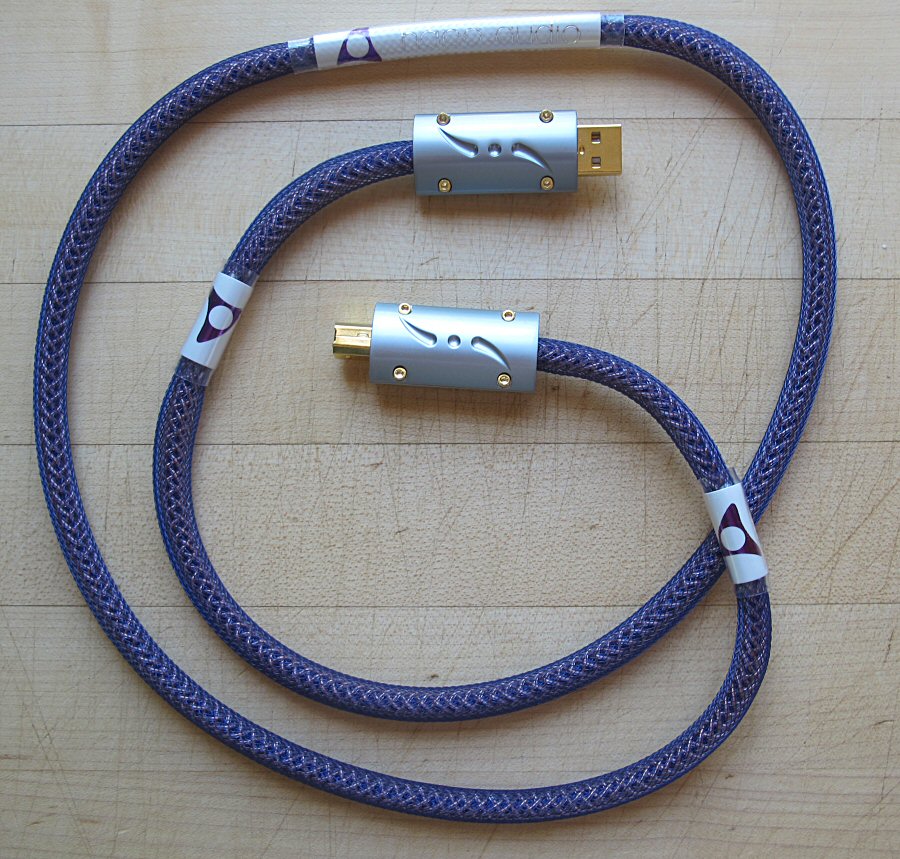This was a fun week, a new
Hapa Ember USB cable and a
new music server. I use the Hapa Quiescence S and Quiescence GS between the DAC - preamp - amp, the Ember USB has a very nice synergy with those interconnects and there is definitely a family resemblance.
The special weave can be seen through the semi-transparant sleeve. The Ember is very flexible, just like the interconnects. The USB conections almost define audiophile jewelry, they are solid metal, easy to hold and look like they will take a lot of abuse.

My system has remained the same as in my
interconnect review except for the music server upgrade. The sound remains the same except now the server works 100% of the time, the old server was 10 years old and had it's share of glitches. Since I reused the PPA card and SSD there was no break-in period, the sound stabilized in an hour and hasn't changed.
Some of the music I listened to with the Hapa Ember USB:

The Hapa Ember USB webpage has a description of the cable construction, it says:
"...While inexpensive USB cables manage to somewhat balance these things, they do so at a substantial loss of fidelity when streaming data leaving a subjectively weak and emotionless performance. The reasons for this are numerous from failure to segregate the 5 volt leg from the data leg properly, to the use of inferior materials."
"...Inside of Ember is an 8 wire teflon insulated packet that has been braided with a specific ratio wherein the data plus and data minus legs are in close proximity, yet do not run parallel. This data bundle is then covered in a silk nylon layer which is then covered with the 5 volt DC leg and common leg that are arranged in a braided geometry based on our DCS Geometry."
Jason takes great care in separating and isolating the 5 volt DC leg so I decided to test his theory by comparing the Ember to my JMaxwell Data Only USB cable which doesn't have a 5v leg at all. My USB/SPDIF converter has it's own linear regulated power supply. I have no idea if the 5v leg is connected inside the converter, it's the best I can do, my AVA DAC doesn't have a USB input.
Comparing the Ember to the JMaxwell was similar to what row you sit in at a concert. The JMaxwell is like row 2, detailed, not brighter but with an immediacy and bite, like sitting close to the band with an excitement you can feel. Separation, image specificity and depth are all pretty good. A front row seat is exciting but sometimes instruments jump out more than others, a horn or singer can really grab and hold your attention but you don't want to listen from the front row all the time. The JMaxwell with the PS Audio Stellar M1200 monoblock amps was like sitting in the best seat at a recording studio.
The Ember USB moves your seat to the 10th row. Still close but not as far back as mid-hall. The sound is still detailed but more like a band playing together. A little more relaxed, more cohesive and better balanced. The Ember makes the sound a musical experience. There is also more hall sound in the 10th row so the "in the room" feeling the Hapa interconnects bring is enhanced. The 3-D space is still there but more so, it's not like the Ember is adding anything, more like it is getting out of the way. Details in recordings are revealed not by adding brightness but by quietness.
I use the JRiver Media Player. I.Greyhound Fan, who's opinion I respect and agree with almost all the time,
thinks JRiver is midfi at best and prefers Bug Head Infinity Blade and Audirvana. Luckily Audirvana has a 30 day free trial, after that it can get expensive with a $5.83 (before VAT) monthly subscription. I still prefer JRiver as my music player. The comparison was interesting, at first Audirvana had slightly attenuated highs which made it sound like there was more bass. I switched to the JMaxwell USB and the correct balance returned. This was using the KingRex UC384 asyc-USB DDC [WASAPI] driver.
For the second trial I put the Ember USB back in and changed Audirvana to use Kernal Streaming. This change made the sound in line with what I heard with JRiver. So either changing USB cables or the digital output in Audivana can make it sound pretty good. Audirvana (Kernal Streaming?) does seem to flatten the sound stage, micro-detail is suppressed so the software is a no-go for me. But if your system doesn't resolve low level information you will never know it is missing.
Based on the differences between audio players, WASAPI, ASIO and Kernal Streaming, Realtek and custom drivers for an audio grade sound card I can see how reviews for USB cables can be all over the place.
Both the JMaxwell and Ember USB cables are excellent, my impression is the difference is like a well done horn speaker and a Salk speaker with the RAAL tweeter. One is immediate and exciting, the other disappears and lets the music flow. Now there certainly is some special synergy going on with all these Hapa cables in the system. What the Ember does with space is easily heard because all Hapa cables are a champ at resolving micro-detail. Reviewers using different interconnects will certainly hear the balanced presentation.
Music lovers who already own Hapa interconnects absolutely need to get the Ember USB cable. I know I will.